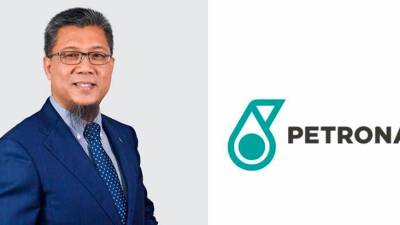KUALA LUMPUR: Petroliam Nasional Bhd (Petronas) expects the low oil price environment to persist, with prices hovering at around US$64 to US$65 (RM270.90) to RM275.10) per barrel, said executive vice-president and chief executive officer (CEO) of upstream business Mohd Jukris Abdul Wahab.
He said the national oil company is reviewing its operational and cost efficiencies in response to the low-price environment, and challenging how it approaches everything – from maintenance, field operations, logistics management and procurement to the running of its offshore and onshore facilities.
“We are reviewing both our operational and cost efficiencies (as) the way we have done things over the past 50 years may not necessarily keep us competitive in the years ahead,” he said during a briefing for editors today.
Also present was senior vice-president of Malaysia assets and Petronas Carigali Sdn Bhd CEO Hazli Sham Kassim.
Mohd Jukris also said the US tariff environment has affected the global supply chain.
“It (the tariff imposition) affects the way we do business. The only thing that we can do is to respond internally and how we drive ourselves to become more cost efficient,” he added.
Replying to a question on portfolio review, Mohd Jukris said the oil company assesses the need to bring in partners to reduce risk exposure, particularly for assets that require high capital investments but deliver limited value.
“Partnerships bring not only capital but also new operating philosophies and standards. In this industry, we can’t operate in isolation. We must identify partners who can operate certain assets more efficiently than we can. This is the best way to unlock maximum value,” he said.
Mohd Jukris said Petronas conducts portfolio reviews from time to time to ensure its assets remain competitive, with each asset having to meet specific standards.
“For example, they must have a break-even price of US$50 per barrel or less. Anything above that raises the question: do we keep this asset or not?
“Operational efficiency is another key criterion. Our unit production cost must remain below US$6 per unit. We set these parameters to guide every portfolio review,” he said.
Petronas has seen its portfolio evolve, including the sale of its gas assets in Azerbaijan and, in 2021 and again last year, the scaling back of operations in Mexico through the exit from eight offshore exploration blocks.
Mohd Jukris also said Petronas is very keen to expand its presence in Canada as the country is now one of its major liquefied natural gas (LNG) suppliers.
He said Petronas has about 50 trillion cubic feet (TCF) of gas in Canada and the current LNG Canada project is only in Phase 1; hence the energy company has embarked on a series of LNG projects backed by this resource portfolio.
“With 50 TCF, we can support several more LNG projects as resource size is not the issue here,” he told an Editors Briefing today.
Mohd Jukris also expressed hope for Canadian government’s support for additional LNG projects. “We are keen to expand our presence there and see Canada as one of our major LNG supply bases going forward,” he said.
Petronas shipped the first LNG cargo from its LNG Canada facility in Kitimat, British Columbia, on July 8.
Petronas operates the North Montney Joint Venture upstream gas project and is a major equity partner in LNG Canada, a US$40 billion LNG facility. – Bernama
